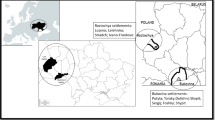Abstract
This paper deals with the botanical study of a family funerary enclosure located in the Porta Nocera necropolis in Pompeii (southwestern Italy). This study is part of a Franco-Italian programme investigating Roman funerary rituals. The choice of the context was due to the exceptional preservation of the archaeological features, which offered the opportunity to observe the remains of the proceedings which took place in a funerary enclosure in great detail. An adequate methodology had to be developed and a 3D recording of every single artefact or ecofact has been made. Both ground surfaces and graves provided botanical results. Those from the ground surfaces consisted mainly of fruit offering residues (especially fig and grape), while a much wider range of species was observed in the tombs, including cereals, pulses, other kinds of fruits, weeds and bread/pastry.








Similar content being viewed by others
References
Bakels CC, Jacomet S (2003) Access to luxury foods in central Europe during the Roman period: the archaeobotanical evidence. World Archaeol 34:542–557
Ciarallo A-M (2000) Gardens of Pompeii. “L’Erma” di Bretschneider, Rome
D’Ambrosio A, De Caro S (1987) La necropoli di Porta Nocera. Campagna di scavo 1983. In: Von Hesberg H, Zanker P (eds) Römische Gräberstrassen. Selbstdarstellung-Status-Standard, Munich, pp 199–228
Jashemski W, Meyer FG, Ricciardi M (2002) Plants: evidence from wall paintings, mosaics, sculpture, plant remains, graffiti, inscriptions, and ancient authors. In: Jashemski W, Meyer FG (eds) The natural history of Pompeii. Cambridge University Press, Cambridge, pp 80–180
Lepetz S, van Andringa W (2004a) Caractériser les rituels alimentaires dans les nécropoles gallo-romaines: L’apport conjoint des os et des textes. In: Barray L (ed) Archéologie des pratiques funéraires; Actes de la table ronde: Archéologie des pratiques funéraires–Approche critique, 7–9 June 2001. Bibracte, pp 161–170
Lepetz S, van Andringa W (2004b) Mourir à Pompéi–La Nécropole De Porta Nocera. Archéologia 416:60–65
Lepetz S, van Andringa W (2007) Archéologie du rituel: Méthode appliquée à l’étude de la Nécropole de Porta Nocera à Pompéi. In: Vivere e Morire Nell’impero Romano. Nuove Prospettive Dell’archeologia Funeraria; Seminario Europeo Di studi
Maiuri A (1978) Pompéi, 13th edn. Instituto Poligrafico Dello Stato, Rome
Meyer FG (1994) Evidence of food plants of ancient Pompeii and other Vesuvian sites. In: Moe D, Dickson JH, Jørgensen PM (eds) Garden history. Garden plants, species, forms and varieties from Pompeii to 1800. Proceedings of the European University Centre for the Cultural Heritage, Ravello, June 1991, Pact, vol 42, pp 19–24
Polfer M (2000) Reconstructing funerary rituals: the evidence of ustrina and related archaeological structures. In: Pearce J, Millett M, Struck M (eds) Burial, society and context in the Roman world. Oxbow, Oxford, pp 30–37
Robinson M (2002) Domestic burnt offerings and sacrifices at Roman and pre-Roman Pompeii, Italy. Veg Hist Archaeobot 11:93–100
Scheid J (1998) La religion des Romains. Collection Cursus, série “Histoire de l’Antiquité”. Masson et Armand Colin Editeurs, Paris
Van Andringa W, Lepetz S (2004) Pompéi, Nécropole De Porta Nocera : Fouille De L’Ensemble Funéraire 23 OS (Campagne 2003), Chronique Activités Archéologiques De L’Ecole Française De Rome, année 2003. MEFRA 116, 2004–1:626–630
Van Andringa W, Lepetz S (2005) Pompéi, Porta Nocera, Archéologie Du Rituel: Fouille De L’Enclos 23 De La Nécropole. Chroniques Activités archéologiques de L’Ecole Française De Rome, année 2004. MEFRA 117, 2005–1:339–346
Acknowledgments
This paper is dedicated to Corrie Bakels on the occasion of her 65th birthday. Her personal involvement as an archaeobotanist in the Aisne valley programme brought to life an entire generation of students in to northern France. Enjoying Neapolitan “holidays” we send a sunny postcard from Pompeii just to say that we are grateful to Corrie for helping us shape our vocations. The authors are very grateful to Jeanine DHOURY, Otto Brinkkemper and Mark Robinson for the language and content improvement of this paper.
Author information
Authors and Affiliations
Corresponding author
Electronic supplementary material
Below is the link to the electronic supplementary material.
Rights and permissions
About this article
Cite this article
Matterne, V., Derreumaux, M. A Franco-Italian investigation of funerary rituals in the Roman world, “les rites et la mort à Pompéi”, the plant part: a preliminary report. Veget Hist Archaeobot 17, 105–112 (2008). https://doi.org/10.1007/s00334-007-0112-z
Received:
Accepted:
Published:
Issue Date:
DOI: https://doi.org/10.1007/s00334-007-0112-z




